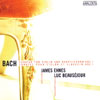Bach Sonatas for Violin and Harpsichord, Vol 1
Well-shaped if a little lush accounts enter the fiercely contested fray
View record and artist detailsRecord and Artist Details
Composer or Director: Johann Sebastian Bach
Genre:
Chamber
Label: Analekta
Magazine Review Date: 6/2005
Media Format: CD or Download
Media Runtime: 59
Mastering:
Stereo
DDD
Catalogue Number: AN29829

Tracks:
| Composition | Artist Credit |
|---|---|
| (6) Sonatas for Violin and Harpsichord, Movement: No. 1 in B minor, BWV1014 |
Johann Sebastian Bach, Composer
James Ehnes, Violin Johann Sebastian Bach, Composer Luc Beauséjour, Harpsichord |
| (6) Sonatas for Violin and Harpsichord, Movement: No. 2 in A, BWV1015 |
Johann Sebastian Bach, Composer
James Ehnes, Violin Johann Sebastian Bach, Composer Luc Beauséjour, Harpsichord |
| (6) Sonatas for Violin and Harpsichord, Movement: No. 3 in E, BWV1016 |
Johann Sebastian Bach, Composer
James Ehnes, Violin Johann Sebastian Bach, Composer Luc Beauséjour, Harpsichord |
| (6) Sonatas for Violin and Harpsichord, Movement: No. 4 in C minor, BWV1017 |
Johann Sebastian Bach, Composer
James Ehnes, Violin Johann Sebastian Bach, Composer Luc Beauséjour, Harpsichord |
Author: Nalen Anthoni
Look at what Bach said: ‘Six sonatas for obbligato harpsichord and solo violin with a bass accompanied by a viola da gamba if you like’. They are, in fact, trio sonatas with the middle and low voices played by the harpsichordist. Andrew Manze and Richard Egarr like the gamba for Nos 1 and 2 only; James Ehnes/Luc Beauséjour and Rachel Podger/Trevor Pinnock, not at all.
Egarr and Pinnock’s recordings give the keyboard its due, and the instrumental perspective reflects Bach’s priorities. Beauséjour’s slender-toned harpsichord, however, doesn’t offer enough sonority for the low voice to speak as authoritatively as it does with Pinnock, in whose performances the absence of a reinforcing gamba is not felt. But he can be a touch square which Beauséjour is not, except in the opening Adagio of No 3.
In his book Authenticity in Performance (CUP: 1990), Peter le Huray – basing his thesis on the writings of Diruta, Mattheson, Quantz and Bach’s cousin Walther – says, ‘We are so accustomed to thinking of rhythmic give and take as a characteristic of romantic music that the idea of a kind of rubato in baroque music may come as something of a surprise’. And rubato, together with Quantz’s belief in the importance of line-shaping, is evident in the approaches of Ehnes/Beauséjour. Sometimes, as in the first movement of No 2, Ehnes produces too lush a sound; but he is not short of variety in his articulation and phrasing, even veering towards severity in the second movement of No 4.
The other artists are equally aware of expressive requirements, and the differences between the three pairs lie in how they weight the various facets of these remarkable works. You really ought to have all the interpretations; and they are sensitively recorded though Podger/Pinnock may need a cutback in volume.
Egarr and Pinnock’s recordings give the keyboard its due, and the instrumental perspective reflects Bach’s priorities. Beauséjour’s slender-toned harpsichord, however, doesn’t offer enough sonority for the low voice to speak as authoritatively as it does with Pinnock, in whose performances the absence of a reinforcing gamba is not felt. But he can be a touch square which Beauséjour is not, except in the opening Adagio of No 3.
In his book Authenticity in Performance (CUP: 1990), Peter le Huray – basing his thesis on the writings of Diruta, Mattheson, Quantz and Bach’s cousin Walther – says, ‘We are so accustomed to thinking of rhythmic give and take as a characteristic of romantic music that the idea of a kind of rubato in baroque music may come as something of a surprise’. And rubato, together with Quantz’s belief in the importance of line-shaping, is evident in the approaches of Ehnes/Beauséjour. Sometimes, as in the first movement of No 2, Ehnes produces too lush a sound; but he is not short of variety in his articulation and phrasing, even veering towards severity in the second movement of No 4.
The other artists are equally aware of expressive requirements, and the differences between the three pairs lie in how they weight the various facets of these remarkable works. You really ought to have all the interpretations; and they are sensitively recorded though Podger/Pinnock may need a cutback in volume.
Discover the world's largest classical music catalogue with Presto Music.

Gramophone Digital Club
- Digital Edition
- Digital Archive
- Reviews Database
- Full website access
From £8.75 / month
Subscribe
Gramophone Full Club
- Print Edition
- Digital Edition
- Digital Archive
- Reviews Database
- Full website access
From £11.00 / month
Subscribe
If you are a library, university or other organisation that would be interested in an institutional subscription to Gramophone please click here for further information.




